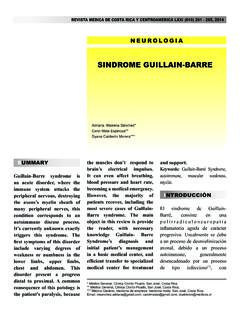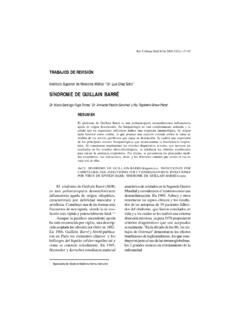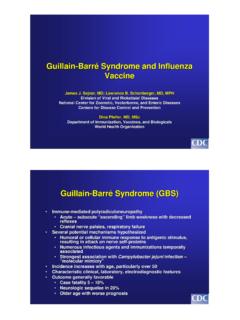Transcription of GUILLAIN-BARRÉ SYNDROME ANAESTHESIA …
1 Sign up to receive ATOTW weekly - email . ATOTW 238 guillain Barre SYNDROME 29/08/2011 Page 1 of 8 guillain - barr SYNDROME ANAESTHESIA TUTORIAL OF THE WEEK 238 29th August 2011 Dr Sonya Daniel ST3, Southampton General Hospital, UK Dr Richard Green Consultant Anaesthetist, Royal Bournemouth Hospital, UK Correspondence to CLINICAL SCENARIO A 68-year-old man is admitted under the physicians with a 10 hour history of gradual onset of tingling and weakness in his arms and legs. This is associated with lower backache. He has recently returned from a two week holiday in Spain, during which time he suffered a self-limiting diarrhoeal illness that he attributed to the hotel food. He has no previous medical history and takes no regular medications. He drinks 12 units of alcohol per week and has never smoked.
2 His vital signs are as follows: blood pressure 100/60mmHg, pulse 120/min (sinus tachycardia on ECG), respiratory rate 24/min, saturations 95% on air and he is apyrexial. On clinical examination there is symmetrically decreased tone and power in the upper and lower limbs. He is unable to move his legs and raises his arms with difficulty. The deep tendon reflexes are absent with down-going plantar reflexes. QUESTIONS 1. Which investigations will aid in diagnosis of this condition? a. Lumbar puncture b. Muscle biopsy c. Full blood count d. Lumbar spine X-ray 2. What complication may be expected with this condition? a. Arrhythmias b. Respiratory failure c. Sickle cell anaemia d. Urinary retention 3. Which of the following are associated with a poor prognosis? a. Precedent Campylobacter jejuni infection b.
3 Antinuclear antibodies c. Insidious onset d. Younger age INTRODUCTION guillain - barr SYNDROME (GBS) is an acute demyelinating polyneuropathy first described in 1859. Its features are those of ascending motor weakness, sensory and autonomic dysfunction frequently following a prodromal illness (usually a respiratory or gastrointestinal infection). It is thought to be autoimmune in origin. GBS can cause significant morbidity requiring long hospital inpatient stay and significant periods of rehabilitation. Approximately 10 15% of patients require assistance with long-term residual disability. Sign up to receive ATOTW weekly - email . ATOTW 238 guillain Barre SYNDROME 29/08/2011 Page 2 of 8 EPIDEMIOLOGY The overall incidence of GBS worldwide is cases per 100,000 per year, with higher rates in males than females.
4 There is a bimodal age incidence, with peaks occurring in young adults and the elderly. The incidence rises to cases per 100,000 per year after 50 years of age. [1,2] There is an association with precedent infections in 70% of cases that are predominantly respiratory and gastrointestinal in origin. It has been suggested there has been an association between GBS and vaccinations, although the evidence for this is weak. [1] CLINICAL FEATURES AND PATHOPHYSIOLOGY Symptoms The clinical features of GBS are variable. Weakness and sensory disturbance are the most common presenting symptoms. There is usually a progressive ascending motor weakness starting in the lower limbs ranging from difficulty walking to paralysis. The weakness may ascend to involve respiratory muscles and cause respiratory failure.
5 Facial nerve palsies are common and there may be associated bulbar weakness and ophthalmoplegia. [3] Sensory symptoms may include pain, numbness and paraesthesia. Pain commonly affects the lower back and may be severe. Numbness and paraesthesia starts distally and ascends in a similar fashion to the motor weakness in 80% of patients. [3] Signs On clinical examination a flaccid areflexic paralysis is found. Muscle wasting usually occurs within two weeks of the onset of symptoms and can be severe. Autonomic dysfunction is common and may cause arrhythmias, swings in blood pressure, urinary retention, paralytic ileus and hyperhydriasis. If severe this may be associated with sudden death. [3] GBS subtypes GBS has a number of recognised subtypes that have differing clinical and pathophysiological features. Acute inflammatory demyelinating polyradiculoneuropathy (AIDP) is the most common form and accounts for around 85 90% of cases.
6 The clinical features are of symmetrical ascending motor weakness with hypo- or areflexia. The underlying pathological process involves inflammation and destruction of the myelin sheaths surrounding peripheral nerve axons by activated macrophages. This leads to slowing and blockage of conduction within peripheral nerves causing muscle weakness. Severe cases may develop secondary axonal damage. [3] Acute motor axonal neuropathy (AMAN) is more common in Japan and China, amongst young people and in the summer months. It has an association with precedent infection with Campylobacter jejuni. Clinical features are similar to AIDP but tendon reflexes may be preserved. Electrophysiological testing may distinguish from other variants as selective motor nerve and axonal involvement is demonstrated. In AMAN the pathological process involves binding of antibodies to ganglioside antigens on the axon cell membrane, macrophage invasion, inflammation and axonal damage.
7 [3] Sign up to receive ATOTW weekly - email . ATOTW 238 guillain Barre SYNDROME 29/08/2011 Page 3 of 8 Acute motor and sensory axonal neuropathy (AMSAN) is a variant of GBS in which both motor and sensory fibres are involved and which can be demonstrated on electrophysiological studies. It is more severe and associated with prolonged or even partial recovery. Clinical features are similar to AMAN but also involve sensory symptoms. The underlying pathological process is similar to that for AMAN ( antibody mediated axonal damage). [3] Miller Fisher SYNDROME (MFS) presents with ataxia, areflexia and ophthalmoplegia. 25% of patients may develop limb weakness. Electrophysiological studies show primarily sensory conduction failure. Antiganglioside antibodies to GQ1b are found in 90% of patients and are associated with ophthalmoplegia.
8 There have been limited pathological studies in MFS but demyelination of nerve roots has been demonstrated. [3] A chronic form of GBS known as chronic inflammatory demyelinating polyradiculoneuropathy has been described. The clinical features are similar to that of AIDP but have a slowly progressive or relapsing course. [3] INVESTIGATIONS [3] Serum biochemistry Urea and electrolytes are usually normal but may have evidence of the SYNDROME of inappropriate ADH secretion (SIADH) or renal dysfunction. ALT and gamma GT may be raised in 33% of patients. Creatine kinase may be raised. Inflammatory markers ESR is usually raised and CRP is sometimes elevated. Antiganglioside antibodies Anti-GM1 is positive in 25% of patients and is associated with a worse outcome.
9 Anti-GD1a is associated with AMAN subtype of GBS. Anti-GQ1b is associated with Miller-Fisher SYNDROME . Infection screen Send serology for Campylobacter jejuni, Cytomegalovirus, Epstein- barr virus, Herpes simplex virus, Mycoplasma pneumoniae. HIV antibodies should be considered. Stool cultures looking for evidence of gastrointestinal infections particularly Campylobacter jejuni. Radiological A CT brain is indicated to exclude other causes of symptoms and evidence of raised intracranial pressure prior to performing a lumbar puncture. An MRI of the spine may show selective anterior spinal nerve root enhancement with gadolinium and will exclude cervical nerve impingement. Lumbar puncture Cell count and glucose are usually normal with a raised protein, although the latter may also be normal in first two weeks.
10 Sign up to receive ATOTW weekly - email . ATOTW 238 guillain Barre SYNDROME 29/08/2011 Page 4 of 8 Nerve conduction studies Findings depend on subtype of GBS. The majority show demyelinating pattern while some patients may show evidence of axonal loss with little or no demyelination. Respiratory function tests These may show reduced vital capacity, maximal inspiratory and expiratory pressures. Arterial blood gases may indicate progressive respiratory failure. DIFFERENTIAL DIAGNOSIS [3] Neurological Myasthenia gravis Eaton-Lambert (myasthenic) SYNDROME Multiple sclerosis Transverse myelitis Metabolic Hypokalaemic periodic paralysis Hypermagnesaemia Hypophosphataemia Acute intermittent porphyria Infective Post diphtheria neuropathy Polio Botulism Tick paralysis Drugs / toxins Heavy metal poisoning ( lead) Biological toxins (including snake and scorpion toxins) Drugs (including stavudine, nitrofurantoin and aminoglycosides) Other Acute polymyositis Critical illness myopathy MANAGEMENT Multi-disciplinary input is important in all aspects of the care of patients with GBS both in the acute phase and rehabilitation of patients.














